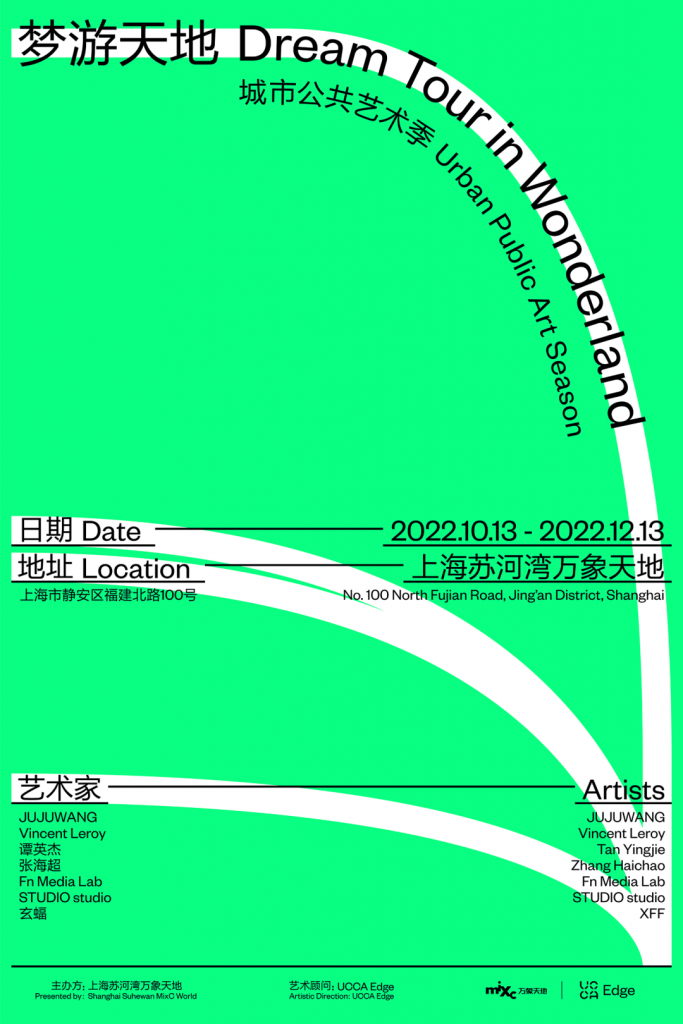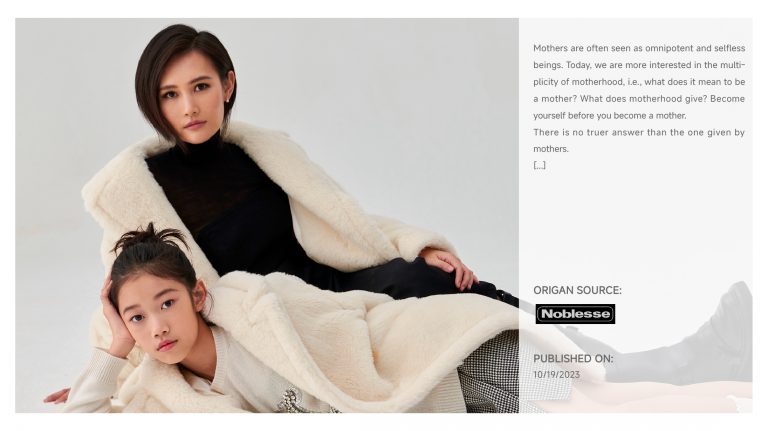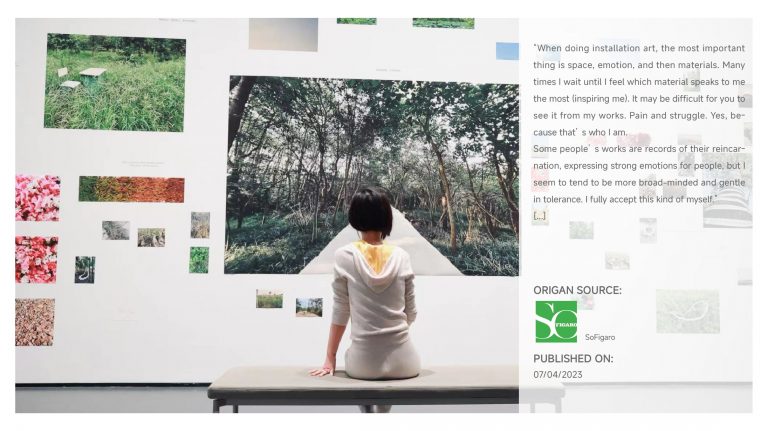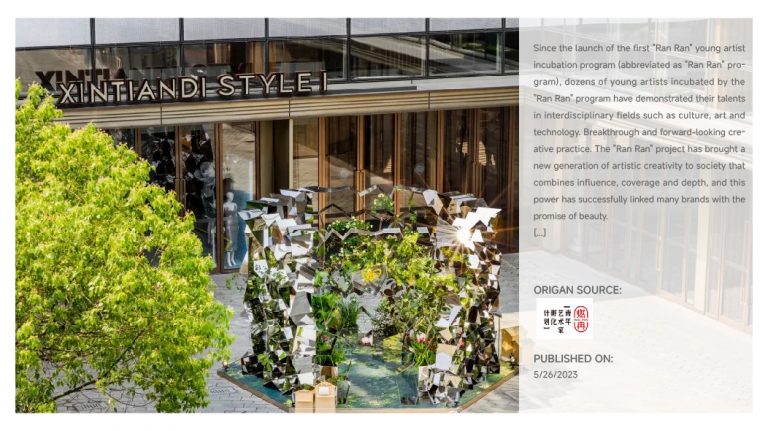Once public art re-anchors itself to the flow of time and space, it will withstand or absorb more audio-visual elements surrounding the space, such as street noise, temperature and humidity, and even the special emotions belonging to “this place”.
Written by Wang Yushen
Image Courtesy UCCA Edge
Compared with art in “white cubes” such as art galleries, museums, and galleries, viewers of public art do not need to have the mentality of “looking at art” to wander around and encounter art randomly. Even the term “audience” seems far-fetched. The purpose of public art is not art itself, but to carry and mobilize the productivity of a specific site as much as possible. The space in which public art is located is the opposite of what Brian O’ Doherty calls “linbo.” It is true that the advantages of public art also mean that it poses challenges to artists. The latter must integrate the work with the space and time in which it is located, rather than hanging alone outside the living world or being overwhelmed by the richness of the living world. What can art do without the protection of the white cube?
In fact, Shanghai has been practicing in the field of urban public art for many years and has formed a large-scale ecology, including some attempts to combine it with commercial space. The latest chapter of this series of practices was on October 13 “Dreamwalking in the World – Urban Public Art Season” will be jointly presented by Shanghai Suhewan Vientiane World and UCCA Edge from December 13th. The project invites artists JUJUWANG, Vincent Leroy, Tan Yingjie, Zhang Haichao, together with Fn Media Lab, STUDIO studio, and the Xuanbat XFF creative group, commissioned the creation in a site with multiple time and space situations by the Suzhou River. The types of works include art installations, algorithmic interactive programs, digital virtual content and AR interactive programs, etc., using contemporary lifestyle and consumption scenes as a stage for public art and its audience. “Dreamwalking in the World” reconstructs the commercial space where the project is located, which makes people think of the original meaning of “city” in the Chinese word “city” and the main content that constitutes our lifestyle today. Rather than saying that public art transforms the city into an “exhibition venue,” it is better to say that public art has returned to the fabric of urban life. The inspiration for “Dream” comes from the sense of traveling through the “hyper-real” world that transcends logic and is full of infinite possibilities in “Alice in Wonderland”, which is consistent with the time and space situation of the site where “Alice in Wonderland” is located. To this end, the curatorial team invited artists to create the image of Alice. As the special experience officer of the art season, the clues that lead the audience into the dream experience are like falling into a “rabbit hole”; the “tour” points to the hydrology of the Suzhou River. The landscape also reminds the subject’s position in the project: the “embodied” wandering and shuttling of the viewer in the exhibition hall corresponds to a special moment in the life world, in which “I” are lost in thought, digressing, and Sleepwalking…
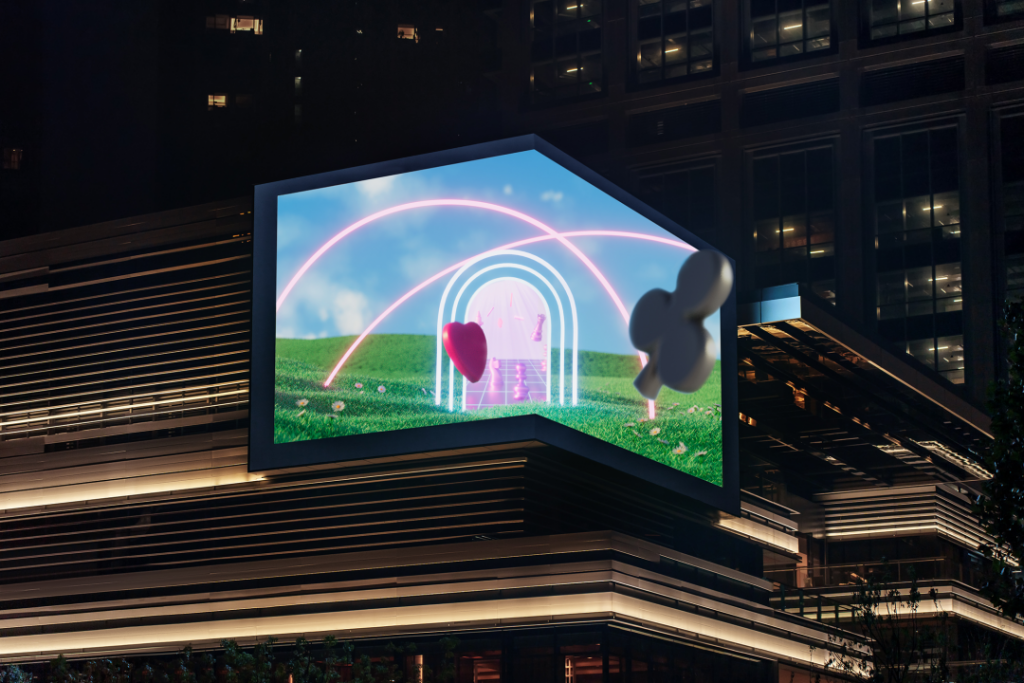
Xuan Bat XFF, “Drama in Suhe”, 2022 / Digital imaging, 30 seconds / Image courtesy of UCCA Edge
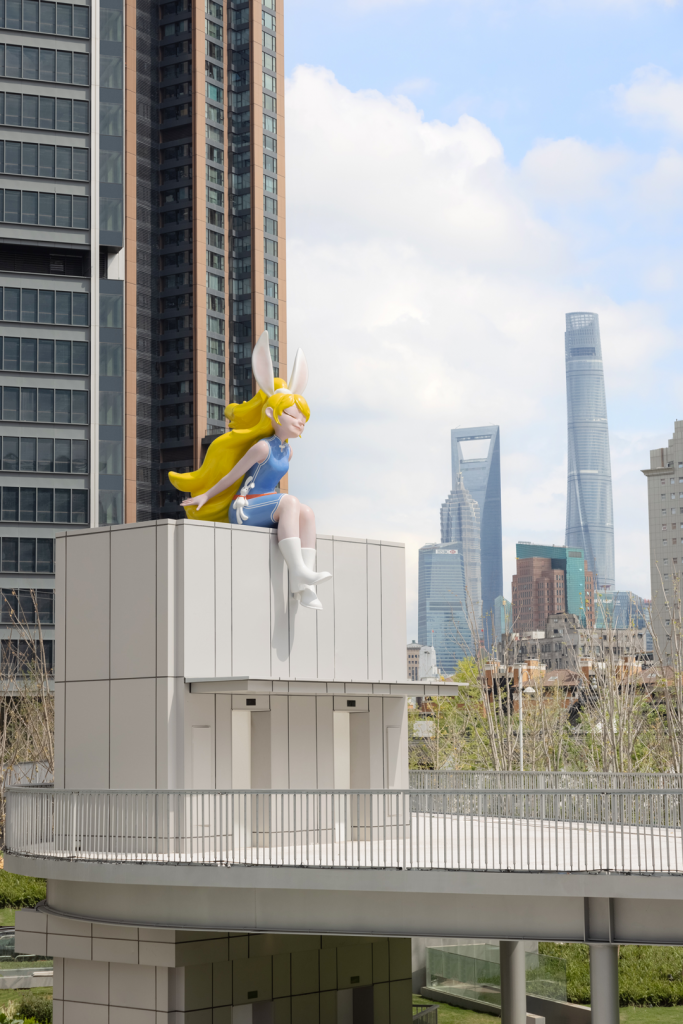
STUDIO studio, “I Encounter 20 Hertz in Urban Decibel”, 2022 / FRP, 5.5 × 3.6 × 2.48 m / Image courtesy of UCCA Edge
Time and space “overlapping scenery”
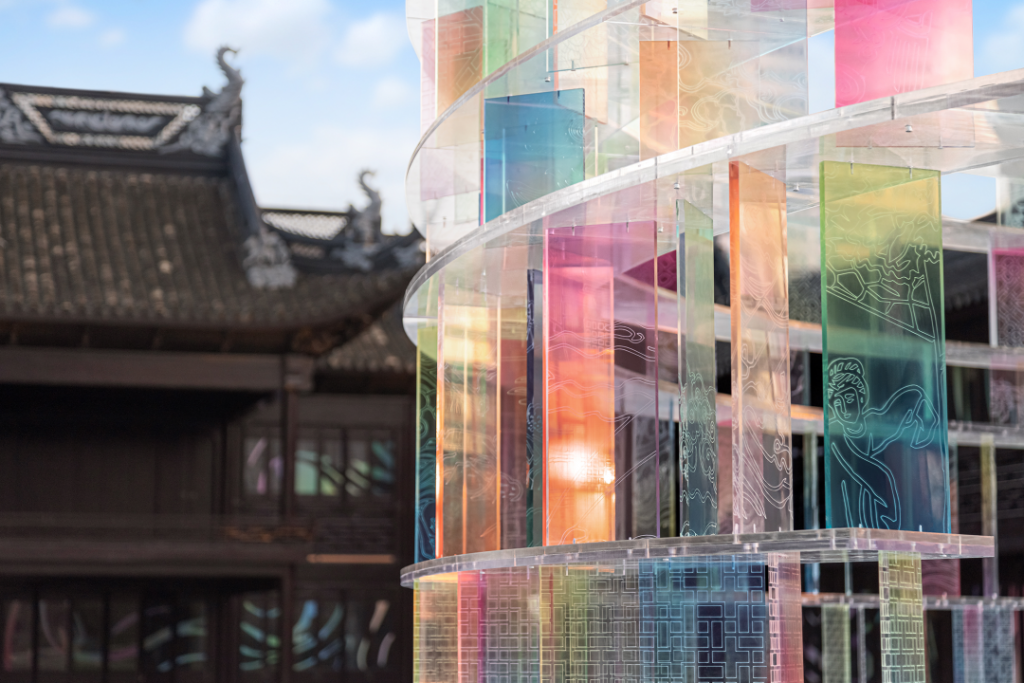
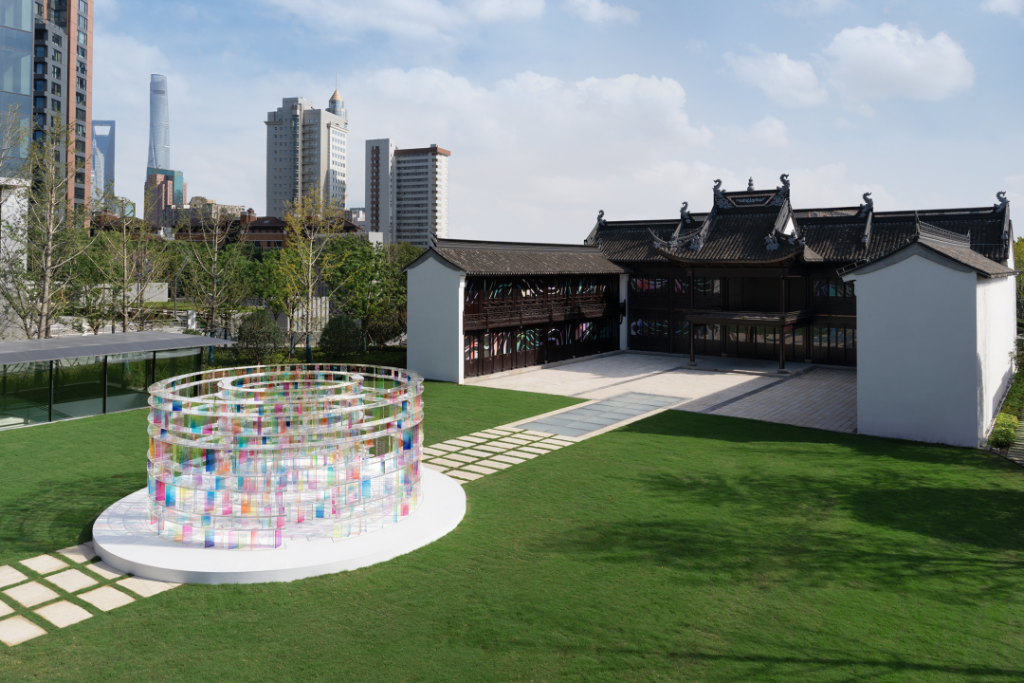
JUJUWANG, “Once Upon a Time”, 2022/ Acrylic, wood, 9 × 9 × 3.3 m / Image courtesy of UCCA Edge
The “Tianhou Temple” , built in 1884 , is an ancient palace-style building in the south of the Yangtze River. It is also the largest, highest-standard, and most complete Mazu temple in the history of Shanghai. It represents the traditional undertones of modern Shanghai and is also a symbol of the city’s intimate relationship with the sea. Nowadays, the east-west viewing towers and stage of Thean Hou Temple have finally been rebuilt recently, while the main hall is being protected and restored off-site. Artist JUJUWANG personifies historical and realistic time and space situations, creating creations around the life of Mazu, the deity enshrined in Thean Hou Temple, and inviting this female image by the Suzhou River. The installation titled “A Long Time Ago” is located at the original site of Thean Hou Temple, opposite the stage, where a fantasy drama symbolizing history and reality is performed together. Inspired by the caisson structure in the center of the stage and the magical life of Mazu, 108 colored acrylic vertical panels form two circles of multi-layered annular structures, completing the original number of columns (106) in Thean Hou Temple to achieve the perfection of the here and now. The images carved on the panels are extracted from the original wood carvings of Thean Hou Temple. The changing light and shadow penetrate the history told by these images and blend with the viewers. JUJUWANG regards this work as an epiphany installation, which is dually blessed by history and reality and subtly affects the viewer over time. In addition, with the help of AR technology, auxiliary artist JUJUWANG conceptually recreated the pillars of the original hall of Thean Hou Temple with the theme of “Exploration and Rebirth”. While “overlaying” the scene with the real city, it also gave a complete view of the Thean Hou Temple complex. A dreamlike blank space is used to leave space for the audience’s imagination.
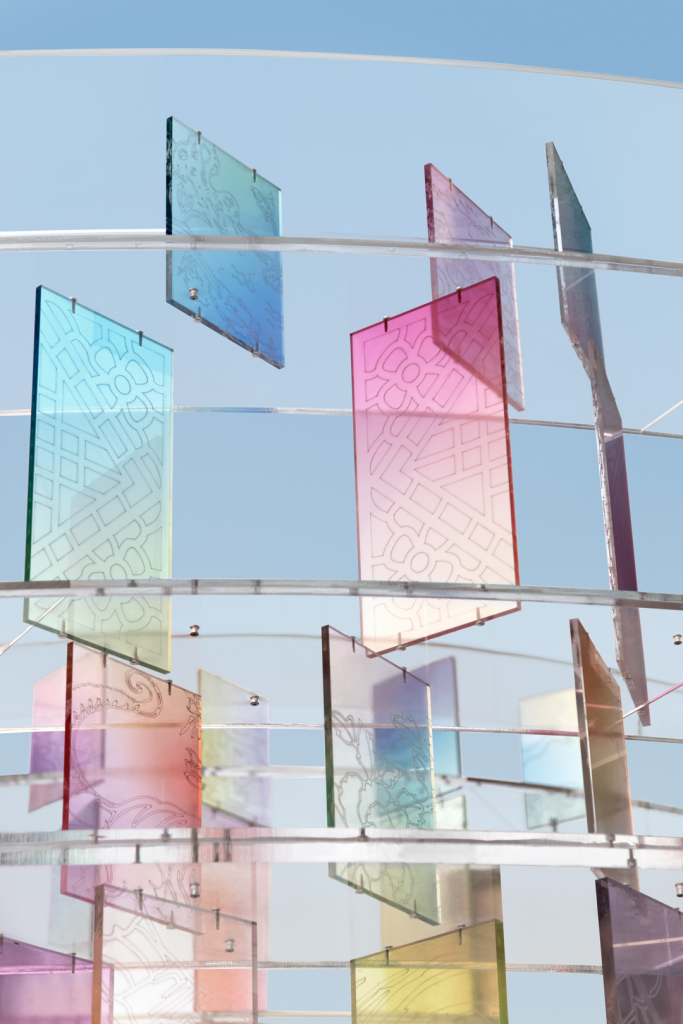
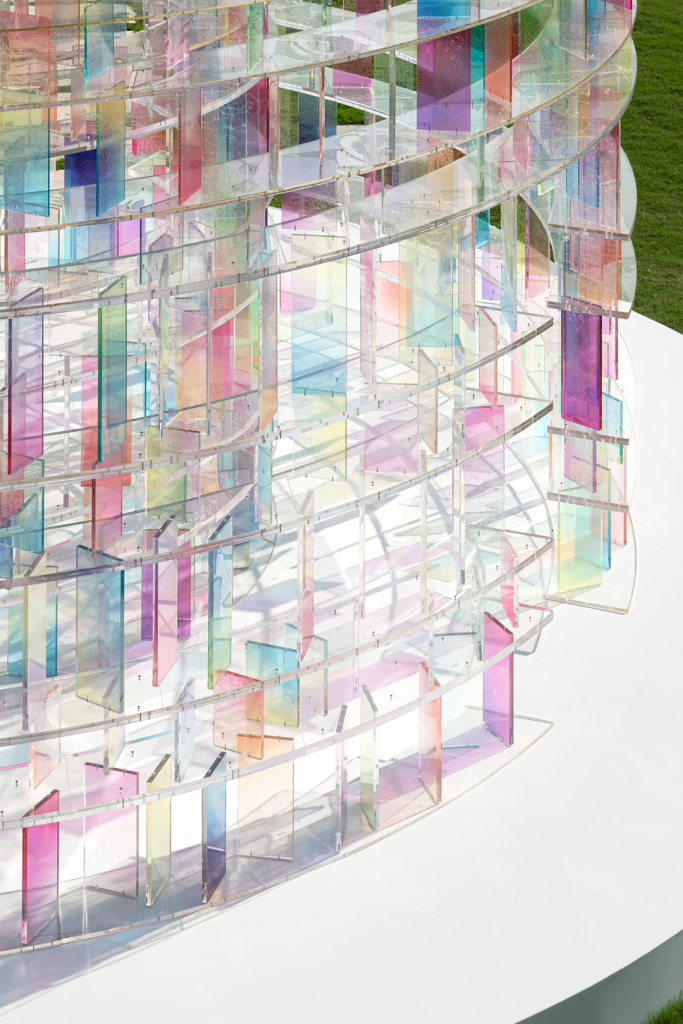
JUJUWANG, “A Long Time Ago” (detail), 2022/ Acrylic, wood, 9 × 9 × 3.3 m/ Image courtesy of UCCA Edge
rediscover
a place”
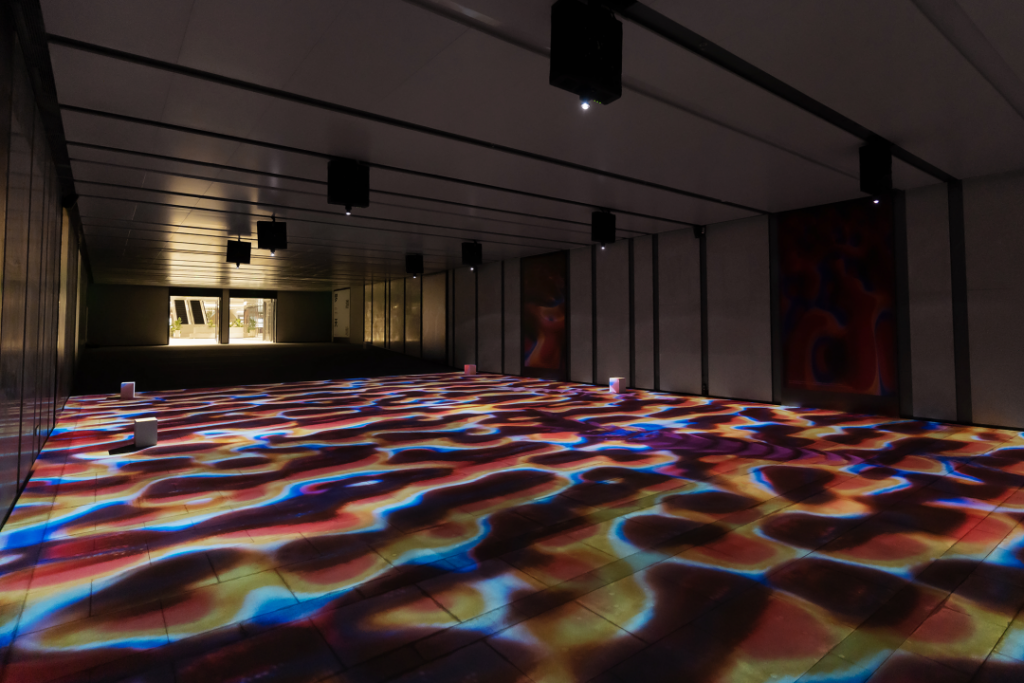
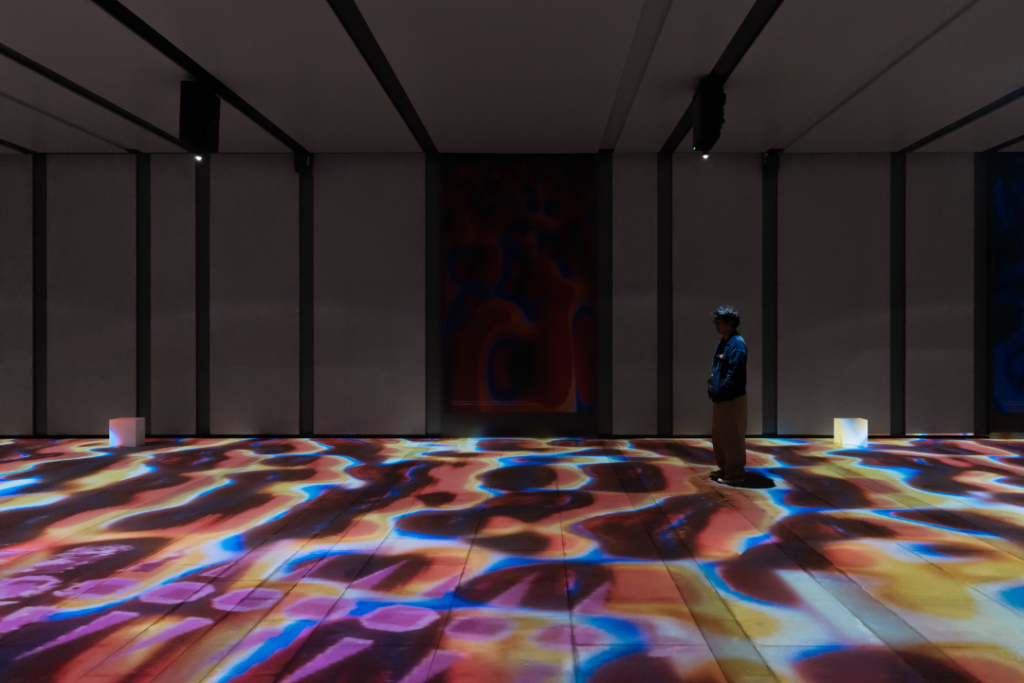
Zhang Haichao, “HELLO WAVE_Mimetic Field OFFLINE”, 2022 / Projection, algorithmic imaging program, lidar, variable dimensions / Image courtesy of UCCA Edge
Water, as a fluid, is similar to the form of dreams. In this sense, “sleepwalking” means swimming in water. In the underground corridor below the Fujian Road Bridge, artist Zhang Haichao’s “HELLO WAVE_Mimetic Field OFFLINE” uses an algorithmic image program to simulate the same-color water wave vision of the Suzhou River where the work is located, and invites the audience to use their bodies to stir up digital ripples. At the same time, the work also obtains sunlight data in real time to generate light effects that are synchronized with the real Suzhou River, thus forming a pseudo-environment with a “pseudo-environment” as the core and biomorphic simulation algorithm images as the visual form. Traveling through it, the audience becomes like the actors in what Lewis Mumford calls “urban drama”, and rethinks the meaning of real urban time and space through digital exoticism. Subsequently, the digital river leads us to a chapter that moves slowly in time and space – “Shen Yuli”, a Shanghai-style Shikumen architectural community that represents the living experience of old Shanghai . French artist Vincent Leroy’s large-scale installation “Slow Motion” composed of 41 Fresnel lenses is swaying in the “draft” at the intersection and reflects the uncertainty of perception of time and space. The artist emphasizes the influence of the open air environment on his works and believes that there is some kind of interaction between the two. Unlike the installation design inside the museum, he hopes to introduce more natural factors, such as wind direction and light, into his works. Therefore, Leroy took advantage of the dreamy light breeze in the streets to easily transform the originally square and straight environment of the alley into a randomly changing visual maze.
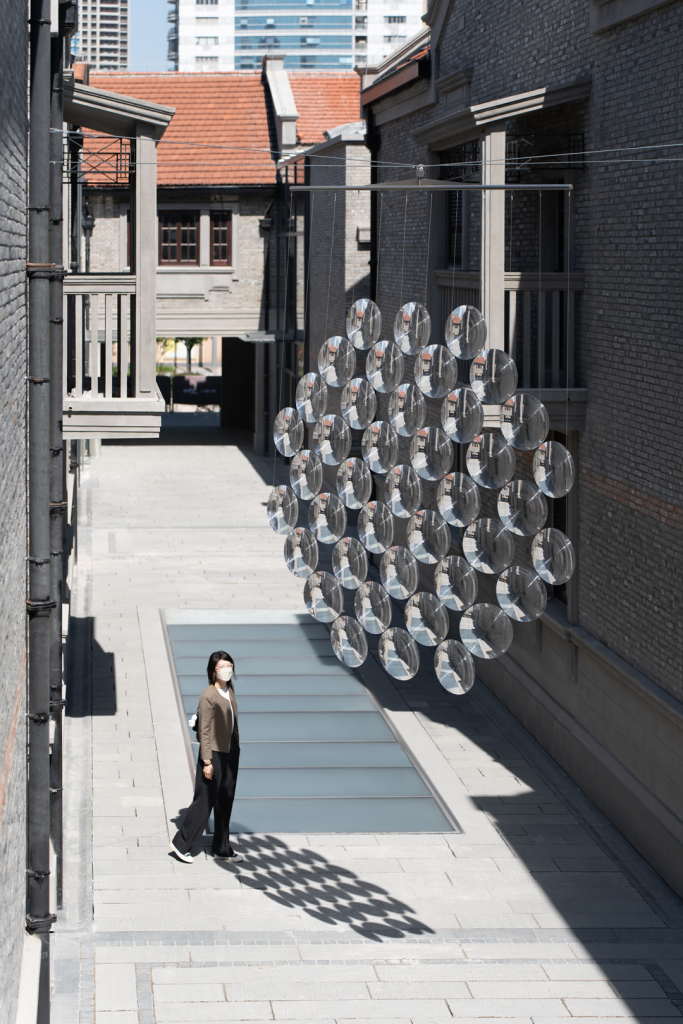
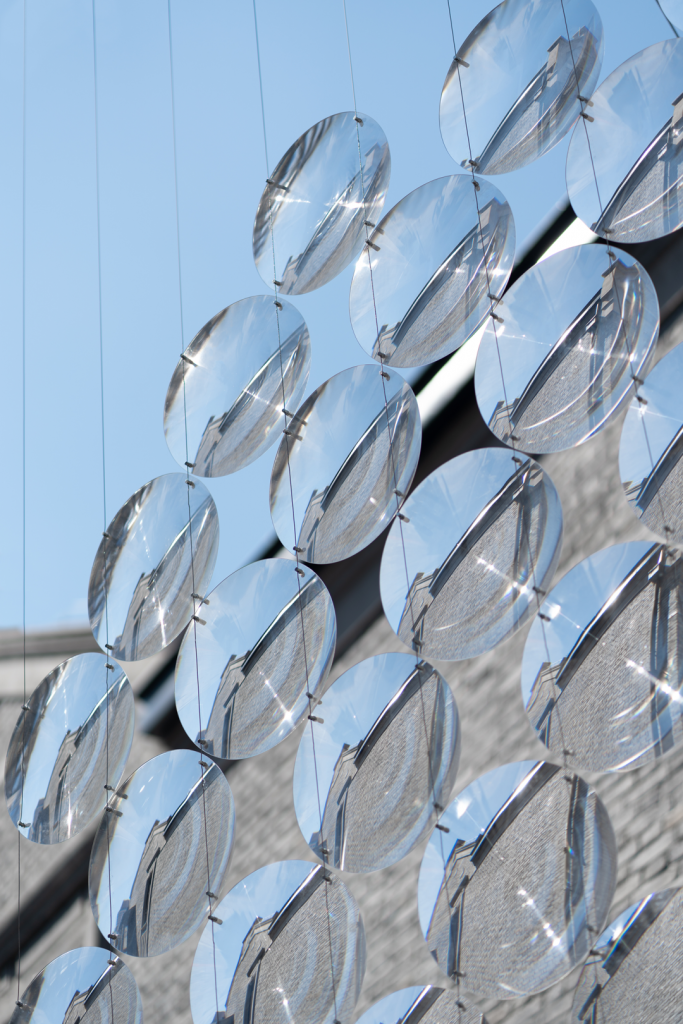
Vincent Leroy, “Slow Motion”, 2022 / Fresnel lens, steel cable, stainless steel structure, 270 × 330 cm / Image courtesy of UCCA Edge
Once public art re-anchors itself to the flow of time and space, it will withstand or absorb more audio-visual elements surrounding the space, such as street noise, temperature and humidity, and even the special emotions belonging to “this place”. Similar to the situation of Thean Hou Temple, Shen Yuli is also a historical district that the restoration team successfully protected and restored using traditional materials and techniques in accordance with historical mapping. The Shanghai-style architecture in Shen Yuli is a sample that carries the rich cultural latitude and longitude of Shanghai. It itself is the product of the impact of traditional Chinese civilization and Western modernity a hundred years ago. It is worth mentioning that in addition to Tianhou Temple and Shen Yuli, the newly renovated Shanghai General Chamber of Commerce, Xintai Warehouse and Sixing Warehouse have jointly restored important fragments of modern urban commercial space along the Suzhou River.
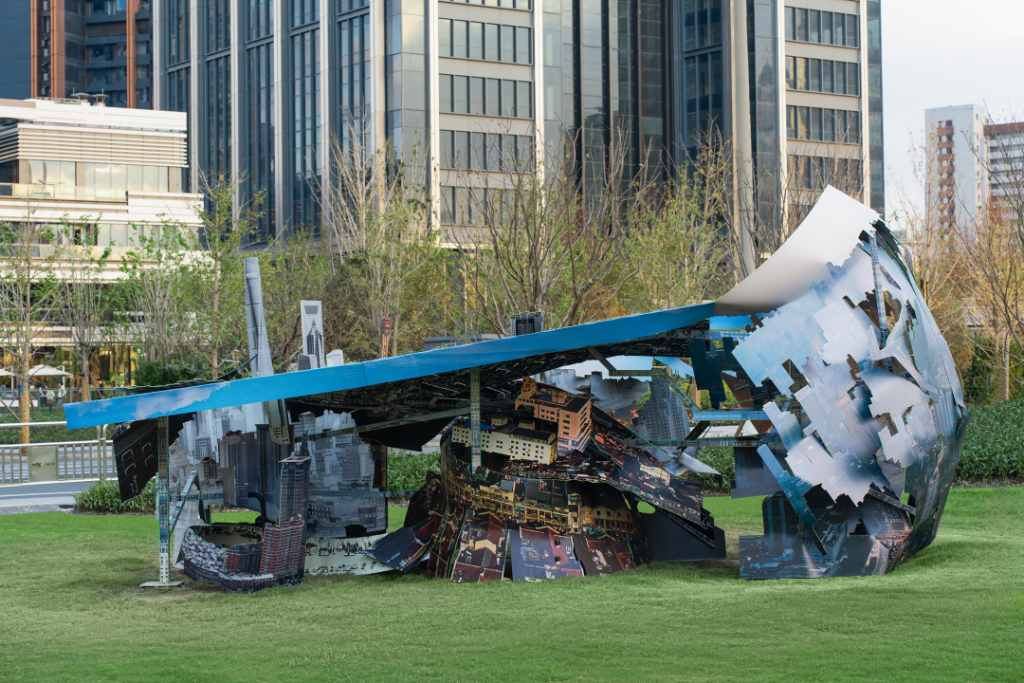
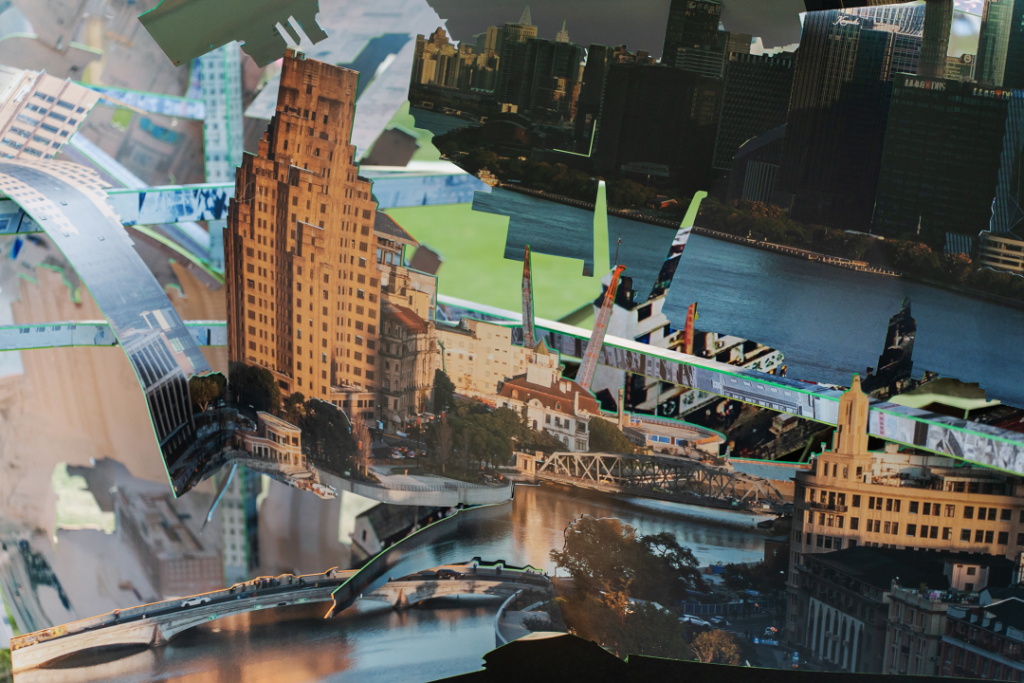
Tan Yingjie, “Shanghai Folding”, 2022 / Aluminum plate, 2.7 × 6 × 2.7 m/ Image courtesy of UCCA Edge
For the artist Tan Yingjie , the word “you” reminds him of the Chinese gardening tradition and the related “mirror world” in the Chinese literary tradition – such as “A Dream of Red Mansions”. In his work “Shanghai Folding”, the artist intercepted images of Shanghai city spanning nearly a hundred years and mirrored them. The hyper-flat images were cut and distorted to construct a picture of Shanghai that is both real and fake. . Fn Media Lab uses linear LED light tubes to “paint” the space. Curves containing local historical memories traverse the site, becoming an open guidance system and establishing a link between cultural heritage buildings and Shanghai-style buildings. The relationship between different spatiotemporal scenes such as building clusters, riverside landscapes, urban green spaces and consumption scenes.
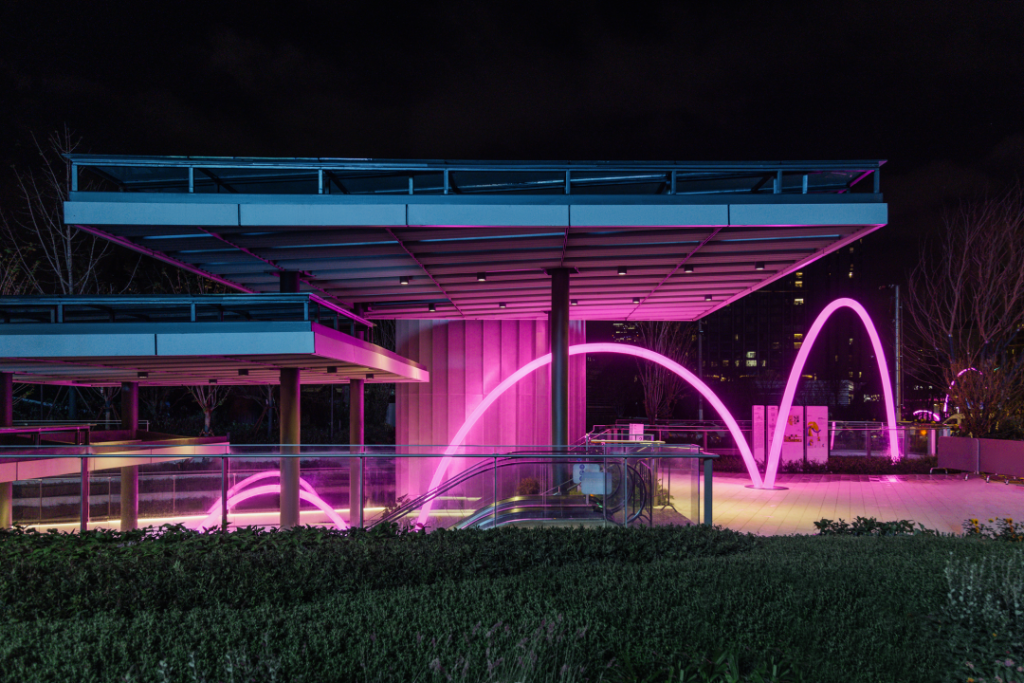
Fn Media Lab, “Memory Curve”, 2022 / Corrugated pipe, metal structure, LED lamp, diameter 0.2 m, total length 114 m / Image courtesy of UCCA Edge
Rabbit Hole: Than Real
more real
Today’s cities and people’s experience in them are undergoing unprecedented changes. “Space” has surpassed the triadic nature of “material/spiritual/social” as mentioned by Henri Lefebvre. Digital/virtual space is accelerating to merge with the former. Reconstructing our reality. Under this new reality, the boundaries between virtual space and time and lived experience are disappearing, and a cyborg space-time continuum has been formed. Virtual and real life scenes are intertwined. Technical prosthetics may extend the dimension of our perception of time and space, but the so-called “reality” may also be a holographic projection that the dreamer is not aware of – or on the contrary, the dream itself is a kind of reality. Form, even “hyper-reality” that is more real than reality. In “Alice in Wonderland,” public art is the “rabbit hole” in “Alice in Wonderland.” In addition to physical art works, “Dream Walking in the World” takes as its main line the large-scale installation “I Met 20 Hertz in the City Decibel” created by STUDIO studio and the naked-eye 3D digital image “Drama in Suhe” produced by Xuanbat XFF, created by STUDIO studio The “Dreams Are Not necessarily Fake” series of AR interactive works are scattered throughout the venue. Following the guidance of the “rabbit hole”, viewers can enter the fantasy “dream” at 5 augmented reality experience points to rethink “truth”. /Fake” to the meaning of life, so as to have freedom in the broader virtual world and technological time and space.
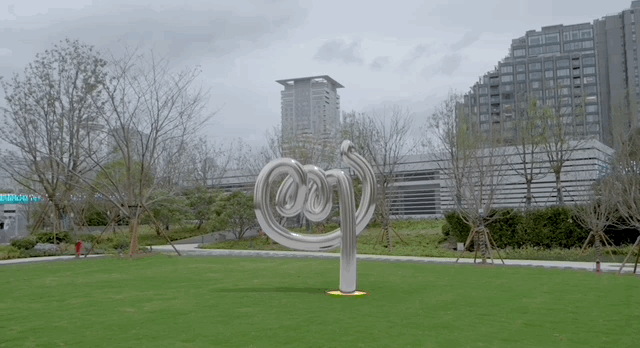
STUDIO studio, “Unconventional 4/5_Rationality does not necessarily exclude innocence” Part2, 2022 / Web program, AR algorithm, virtual scene, variable size / Demonstration effects provided by the artist
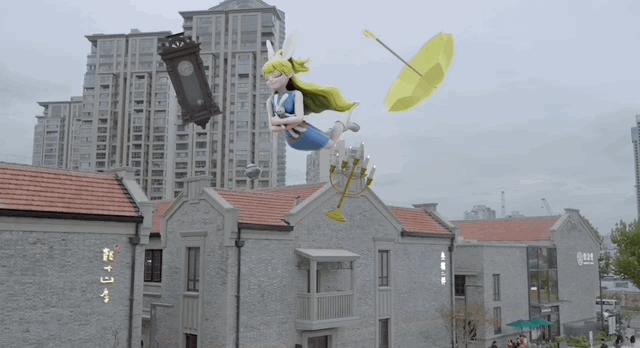
STUDIO studio, “Unconventional 5/5_Objectivity does not necessarily drown out curiosity”, 2022 / Web program, AR algorithm, virtual scene, variable size/ Demonstration effects provided by the artist

STUDIO studio, “Unconventional 2/5_Code Does Not Kill Romance”, 2022 / Web program, AR algorithm, virtual scene, variable size / Demonstration effects provided by the artist
Perhaps the best state of art is when no one notices it, it is already completed, like an anonymous draft in an alley. On the banks of the Suzhou River at night, the two light beams in “Memory Curve” simply jump underground, declaring a literal “locality”. However, the remaining beams of light, wrapped in the collective memories and dreams of people in the city, gradually disappeared into the phantom of ripples.
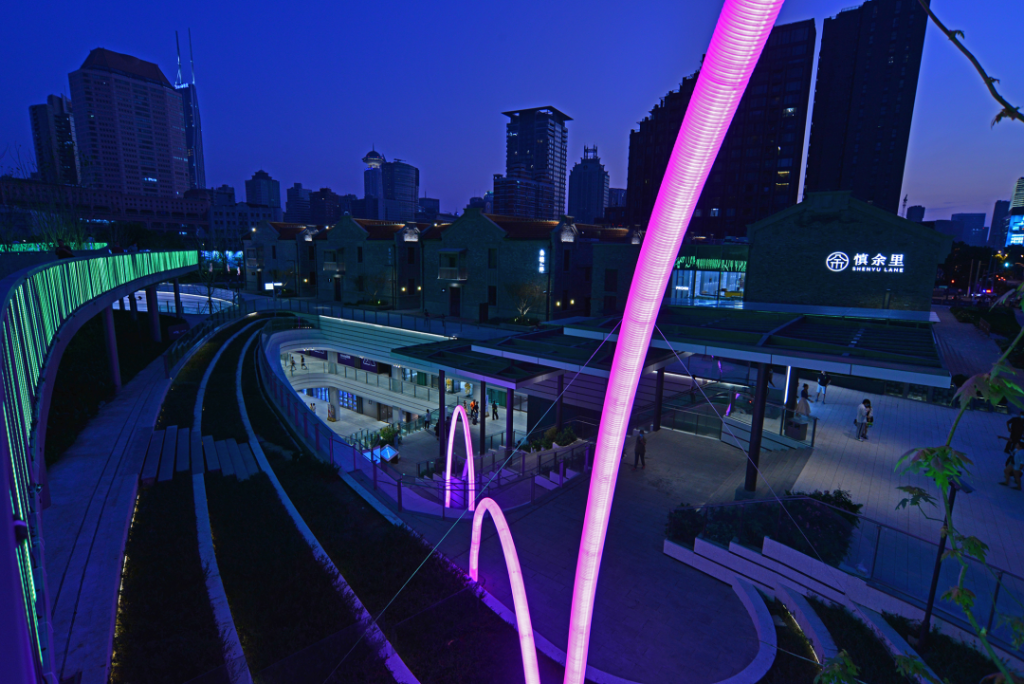
Fn Media Lab, “Memory Curve”, 2022/ Corrugated pipe, metal structure, LED lamp, diameter 0.2 m, total length 114 m / Image courtesy of the artist
